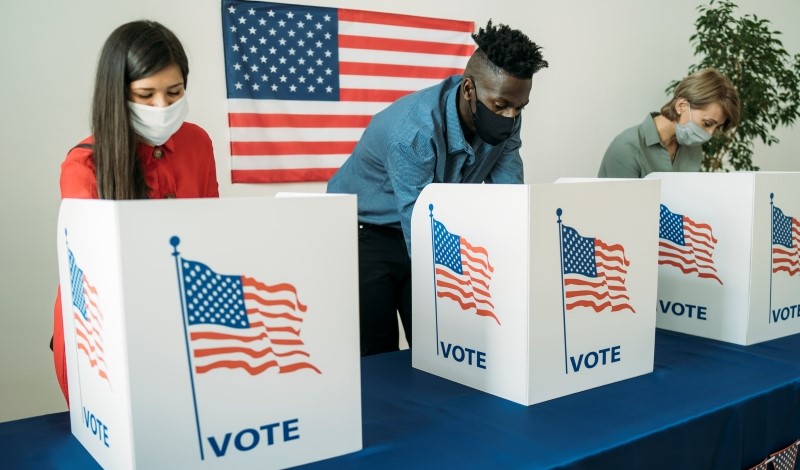
Medicaid expansion ballot initiatives show state referenda can expand health care access—but they have their limits.
State ballot initiatives protecting reproductive rights across the country signal the public’s rejection of the U.S. Supreme Court’s decision overturning constitutional protection for abortions in Dobbs v. Jackson Women’s Health Organization. Although some political experts are celebrating these ballot initiatives as a reproductive rights triumph, and rightly so, they should also be understood as qualified wins. These state efforts, and those that preceded them in recent years, aim to increase access to health care—they also shine a light on larger political process failures and the limits of correcting them. To address these failures, ballot initiatives must be fought and passed state by state. When reproductive and other health care access is left to referendum, it inevitably leaves gaps that are unevenly felt.
The trajectory of state-level initiatives seen since Dobbs is not a new phenomenon in health care. Over the past six years, numerous Medicaid expansion ballot initiatives have corrected for coverage gaps created in the wake of the Supreme Court’s 2012 decision in NFIB v. Sebelius. This decision left expansion of health care to low-income populations in the hands of elected state representatives, many of whom have failed to act. Voters in seven states—Idaho, Maine, Missouri, Nebraska, Oklahoma, Utah, and South Dakota—rejected their legislators’ inaction at the polls by petitioning for state referenda.
The Fairness Project, a nonprofit dedicated to using ballot measures to circumvent deadlocks in legal change, spearheaded the movement to expand Medicaid through state ballot initiatives. Working with local partners, the organization helped Maine become the first state in the country to approve Medicaid expansion through a ballot initiative in 2017. The Fairness Project subsequently led successful referendum campaigns in Idaho, Nebraska, Utah, Oklahoma, Missouri, and South Dakota.
American health system historian Paul Starr has commented that “the history of health insurance protection until the Supreme Court’s decision on the Affordable Care Act in 2012 was almost entirely a history of legislative and administrative decisions.” But recently, ballot initiatives have become the almost exclusive path to Medicaid expansion.
Despite Republican state governments’ resistance to expansion in the wake of Sebelius, expansion measures have almost always passed once on the ballot. In South Dakota, for instance, voters bypassed the state’s conservative legislature, ensuring Medicaid coverage for 45,000 additional South Dakotans.
Medicaid expansion efforts in the aftermath of Sebelius have paved the path for today’s state-level abortion initiatives. After Dobbs eliminated the federal constitutional right to abortion, voters in seven states—California, Michigan, Montana, Vermont, Kansas, Kentucky, and Ohio—protected the right to abortion at the state level by ballot initiative in a variety of ways. Kentucky rejected a constitutional amendment that would have prevented any state court from affirming a right to abortion. California amended its state constitution to prohibit interference with an individual’s reproductive freedom. And Montana voters rejected a state bill mandating that providers sustain infants born at any stage.
Last November, Ohio voters approved a ballot initiative for a state constitutional amendment codifying abortion as legal. Ohio’s success is especially significant considering the existence of aggressive anti-abortion efforts in the state. Hours after Dobbs was decided, Ohio reinstated a ban on abortions after six weeks. Although subsequent litigation supported by Planned Parenthood and the American Civil Liberties Union blocked enforcement of the ban, the legal uncertainty and fear of retribution chilled providers and reduced abortion access throughout the state. Republican lawmakers also attempted to curb the ballot initiative before it even took place by including a measure on Ohio’s August special election ballot to require a supermajority for amendments to the state constitution. But voters last summer overwhelmingly rejected the Republican attempt to block abortion protections.
Despite these successes, there is a limit to what state ballot initiatives can ultimately achieve. With Medicaid, 10 states, including Texas, Florida, and Wisconsin, have still not expanded coverage—a gap that leaves millions of the lowest-income Americans in these states uninsured.
And it will prove challenging to achieve Medicaid expansion in these holdout states. Florida is the only non-expansion state remaining that allows for a ballot initiative process that could enable expansion. The Mississippi state supreme court eliminated the state ballot initiative process in 2021, halting expansion efforts in the state. And in the remaining states, if ballot initiatives were allowed, they almost certainly would pass. Polls indicate that 70 percent of Kansas voters support Medicaid expansion, for example, and yet the Republican legislature refuses to act. Even when the American Rescue Plan Act increased the federal matching rate for the expansion population, politicians in non-expansion states still balked.
Low-income residents in non-expansion states continue to lack health insurance coverage, with 1.9 million falling in the coverage gap. Although Medicaid expansion is more widespread than some observers anticipated following NFIB v. Sebelius, state successes have not fully substituted for nationwide coverage. The same is likely to be true for reproductive care. Although state efforts will provide important access and protections, gaps that endure will come at a great cost to health justice and equity.
The success of Ohio’s abortion ballot has galvanized campaigns in Nevada, Florida, Pennsylvania, Arizona, Nebraska, Missouri, and South Dakota, but these campaigns may still face roadblocks—legal, political, and practical. For example, a Nevada judge recently struck down a proposed abortion rights ballot measure by Nevadans for Reproductive Freedom that would enshrine a fundamental right to reproductive freedom in the state’s constitution. Although the organization awaits a new decision on appeal, it has also pursued an alternative, less expansive ballot initiative that would guarantee the right to abortion only until fetal viability or when needed to protect the health of a pregnant patient. In Florida, a proposed ballot measure garnered the requisite signatures for the 2024 ballot, but the state supreme court is currently reviewing it in response to calls from the state Attorney General and other opponents seeking to block the measure.
In states that do not allow ballot initiatives, such as Texas and Kansas, legislatures have imposed restrictions contrary to the preference of a majority of residents in those states. Not only is abortion banned in almost all circumstances in Texas, but a few counties have also passed ordinances outlawing travel on local roads to seek an abortion.
After the Supreme Court overturned Roe v. Wade, nearly half of the states enacted outright bans or gestational limits on abortion. In addition, over two thirds of obstetrician gynecologists nationwide report that the Dobbs decision has worsened their ability to manage pregnancy-related emergencies. Ballot initiatives offer progress for restoring abortion rights, and health care access more generally. But without federal action, those rights will only reach some people.





